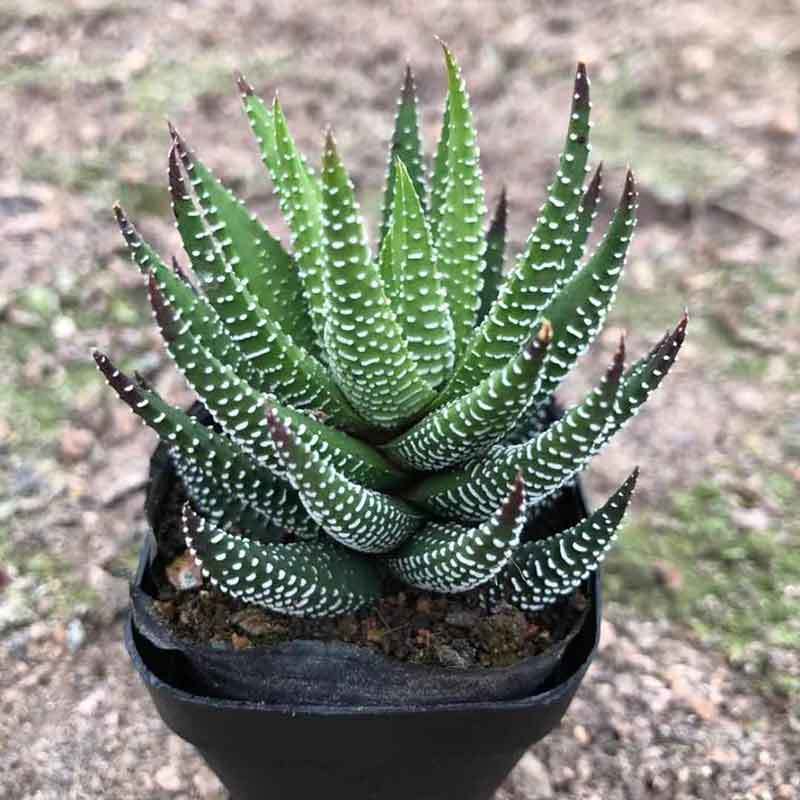Haworthia Turning Purple: Causes and Solutions
Introduction
Haworthia turning purple can be perplexing for plant owners. Understanding the reasons can put your concerns to rest.
What is Haworthia?
Description of Haworthia Plants
Haworthias are a genus of small succulent plants within the larger family of Xanthorrhoeaceae. It also includes aloe and gasteria plants. They originate from South Africa. Haworthias prefer a dry environment with lots of sunlight.
With over sixty recognized species, Haworthias have different shapes, sizes, and textures. But their most distinguishing feature is the window-like patterns on their leaves, which allow them to lessen their sun exposure.
Popular Varieties of Haworthia
Haworthia cooperi: It has thick, fleshy leaves. This variety is notorious for its tendency to turn a pinkish-purple in strong light.
Haworthia fasciata: Also known as the "Zebra Plant". The striking white lines on its dark green leaves. This variety displays a rare and alluring purple blush.
Haworthia cymbiformis: This type develops a distinctive purple coloration at the tips of its leaves. Particularly when kept on the drier side.
Why Do Haworthias Turn Purple?
Environmental Factors
Sunlight Exposure: Intense sunlight triggers the production of anthocyanin as a sunblock. This protects the plant's delicate tissues from too much UV radiation.
Temperature Fluctuations: Cold or heat stress can also be a catalyst for purple pigmentation. An abrupt change in temperature can cause haworthia turning purple. For example, a sudden cold snap in late autumn or spring. It produces anthocyanin in response to stress.
Stress Responses
Overwatering: Too much water can lead to root rot and a decline in the plant's overall health. Haworthia turning purple due to overwatering. This is often a sign of a lack of oxygen in the root system.
Underwatering: On the opposite end of the spectrum, underwatering can leave your haworthia dehydrated. In response, the plant can change color to a purplish hue as a response to stress.
Root Damage: Overwatering, repotting shock, or pests may damage the roots of your haworthia. The purple discoloration might indicate that the plant is using its pigments to respond to the injury.
Nutritional Deficiencies
Lack of Essential Nutrients: Nutritional deficiencies are a common culprit for haworthia turning purple. Haworthias are generally tolerant of less-than-ideal conditions. It requires proper nutrition to thrive.
A shortage of essential nutrients can lead to pigmentation changes. For example, phosphorus and zinc. This means your plant isn't getting all it needs from its soil.
Imbalanced Soil pH: Another potential reason for this shift is the soil pH. If the soil is too acidic or too alkaline, it can affect the haworthia to take up nutrients effectively. This leads to a nutritional imbalance and thus, the color changes.
Genetic Factors
Natural Pigmentation Variations: Natural pigmentation variations are the simplest explanation. The purple color might be part of the species' repertoire. It may be triggered by specific environmental cues.
Genetic Mutations: New shoots or 'pups' of some haworthia species may exhibit purple coloration. Because genetic mutation affects the pigmentation process.

Signs and Symptoms of Purple Haworthias
Visual Cues Indicating a Purple Hue
Watch for leaves that appear slightly translucent and darker under direct light. The purple may be more pronounced in older leaves and those subjected to the most intense light. The variations in the leaves becoming less distinct as the purple becomes more uniform.
Changes in Plant Behavior and Growth Patterns
Alongside the change in color, your Haworthia might exhibit signs of slow growth. The leaves appear somewhat retracted or with a slightly wrinkled texture. This is a sign the plant is conserving resources in response to environmental stress.
Solutions and Remedies
Adjusting Environmental Conditions
Proper Sunlight Exposure: Ensure your haworthia is getting the right amount of indirect sunlight. A good rule of thumb is at least four hours of indirect light per day. If it's receiving too much or too little, it's time to move its location.
Maintaining Consistent Temperatures: Succulents thrive in regular, moderate temperatures. Avoid placing your haworthia in drafty areas or locations with large temperature shifts. Try to keep it in a range of 70°F to 90°F.
Adjusting Watering Frequency and Technique: The soil should be completely dry before watering again. Thoroughly moisten the soil when you water. Allow it to dry out fully before the next cycle.
Managing Stress Factors
Implementing a Suitable Watering Schedule: Establish a proper watering routine based on the species and location of your haworthia. Stick to it, and observe how the plant responds.
Avoiding Root Disturbance: Transplanting or shifting your haworthia frequently can lead to root damage and stress. Leave your haworthia in its pot for as long as possible. When it is necessary to move it, be as gentle as you can with the roots.
Providing Adequate Drainage: Ensure your haworthia is potted in well-draining soil. Your pot should have drainage holes and excess water can escape. Stagnant water can lead to root rot.
Addressing Nutritional Deficiencies
Soil Testing and Amendment: Start by testing the soil to identify any potential deficiencies. If the soil lacks nutrients, you'll need to amend it. You can use a balanced, all-purpose fertilizer or use supplements. For example, compost or plant food.
Fertilization Practices: When fertilizing Haworthias, always follow the instructions on the label. Over-fertilization can be as problematic as under-fertilization. It can cause toxicity in plants. Remember, less is often more with succulents.
Monitoring Genetic Factors
Acceptance of Natural Variations: Sometimes Haworthias are just expressing natural genetic diversity. The color change is simply a shift in pigment production, not a response to any particular stress. In such cases, the plant is otherwise healthy and thriving. So there's no need to intervene.
Isolation of Mutated Plants If Necessary: If you're growing Haworthias for breeding purposes, you might isolate plants that change color. However, for the average grower, this genetic variation is often just part of the plant's charm.
Conclusion
You can help your haworthia return to its vibrant green by addressing these factors. Remember, observation is key. Adjust your care routine accordingly.

